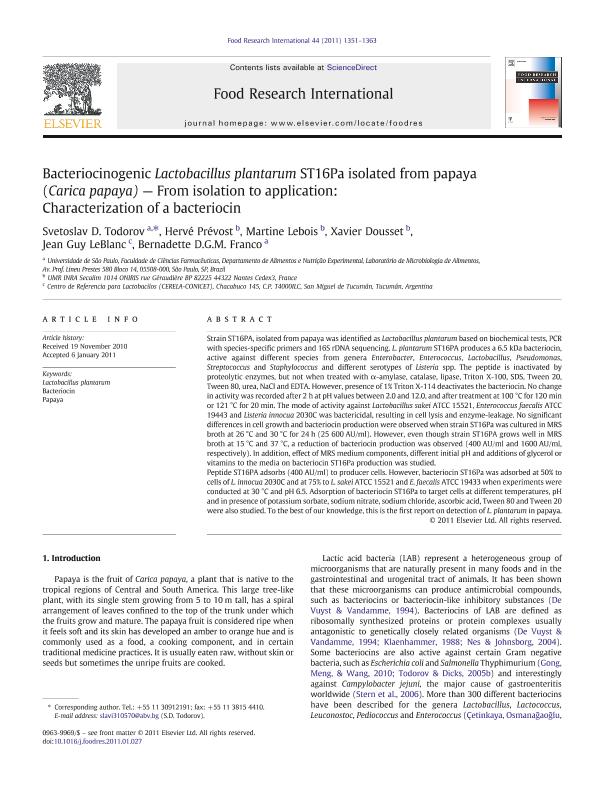Artículo
Bacteriocinogenic Lactobacillus plantarum ST16Pa isolated from papaya (Carica papaya) - From isolation to application: Characterization of a bacteriocin
Todorov, Svetoslav D.; Prevost, Hervé; Lebois, Martine; Dousset, Xavier; Leblanc, Jean Guy Joseph ; Franco, Bernadette D. G. M.
; Franco, Bernadette D. G. M.
 ; Franco, Bernadette D. G. M.
; Franco, Bernadette D. G. M.
Fecha de publicación:
06/2011
Editorial:
Elsevier Science
Revista:
Food Research International
ISSN:
0963-9969
Idioma:
Inglés
Tipo de recurso:
Artículo publicado
Clasificación temática:
Resumen
Strain ST16PA, isolated from papaya was identified as Lactobacillus plantarum based on biochemical tests, PCR with species-specific primers and 16S rDNA sequencing. L. plantarum ST16PA produces a 6.5. kDa bacteriocin, active against different species from genera Enterobacter, Enterococcus, Lactobacillus, Pseudomonas, Streptococcus and Staphylococcus and different serotypes of Listeria spp. The peptide is inactivated by proteolytic enzymes, but not when treated with α-amylase, catalase, lipase, Triton X-100, SDS, Tween 20, Tween 80, urea, NaCl and EDTA. However, presence of 1% Triton X-114 deactivates the bacteriocin. No change in activity was recorded after 2 h at pH values between 2.0 and 12.0, and after treatment at 100. °C for 120 min or 121. °C for 20 min. The mode of activity against Lactobacillus sakei ATCC 15521, Enterococcus faecalis ATCC 19443 and Listeria innocua 2030C was bactericidal, resulting in cell lysis and enzyme-leakage. No significant differences in cell growth and bacteriocin production were observed when strain ST16Pa was cultured in MRS broth at 26. °C and 30. °C for 24 h (25 600 AU/ml). However, even though strain ST16PA grows well in MRS broth at 15. °C and 37. °C, a reduction of bacteriocin production was observed (400 AU/ml and 1600 AU/ml, respectively). In addition, effect of MRS medium components, different initial pH and additions of glycerol or vitamins to the media on bacteriocin ST16Pa production was studied.Peptide ST16PA adsorbs (400 AU/ml) to producer cells. However, bacteriocin ST16Pa was adsorbed at 50% to cells of L. innocua 2030C and at 75% to L. sakei ATCC 15521 and E. faecalis ATCC 19433 when experiments were conducted at 30. °C and pH 6.5. Adsorption of bacteriocin ST16Pa to target cells at different temperatures, pH and in presence of potassium sorbate, sodium nitrate, sodium chloride, ascorbic acid, Tween 80 and Tween 20 were also studied. To the best of our knowledge, this is the first report on detection of L. plantarum in papaya.
Palabras clave:
Bacteriocin
,
Lactobacillus Plantarum
,
Papaya
Archivos asociados
Licencia
Identificadores
Colecciones
Articulos(CERELA)
Articulos de CENTRO DE REFERENCIA PARA LACTOBACILOS (I)
Articulos de CENTRO DE REFERENCIA PARA LACTOBACILOS (I)
Citación
Todorov, Svetoslav D.; Prevost, Hervé; Lebois, Martine; Dousset, Xavier; Leblanc, Jean Guy Joseph; et al.; Bacteriocinogenic Lactobacillus plantarum ST16Pa isolated from papaya (Carica papaya) - From isolation to application: Characterization of a bacteriocin; Elsevier Science; Food Research International; 44; 5; 6-2011; 1351-1363
Compartir
Altmétricas



